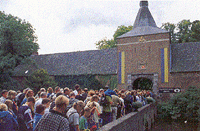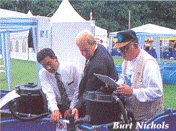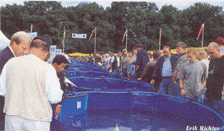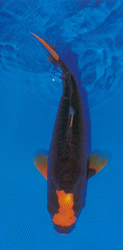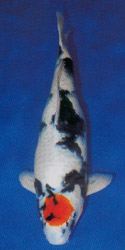"The 7th Dutch Koi Days" or "Goed gereedschop hangt onder een afdak" December is a time when all is quiet here in Seattle. The sky is invariably a dark shade of gray, and the incessant rains for which Seattle is so famous, are in high gear. It was at the height of this dreary climate, that I received an invitation from Holland to participate in judging the 7th Dutch Koi Days, which were to be held August 21, and 22, 1999. The thought of blue skies, windmills and tulips was irresistible, and I quickly emailed my acceptance to Walter Golsteijn, who is Chairman of the Dutch Koi Society and also chairs their annual "Dutch Koi Days" event. The advent of spring '99 brought the busiest koi season we have ever experienced here in the United States. The number of new ponds and new water garden business start-ups was simply phenomenal. So when Walter emailed me just two weeks before the event asking for my itinerary, my first reaction was that of total panic. How could I possibly leave the United States in the middle of peak season? Who's bright idea had it been to commit to these dates? My wife was kind enough to remind me that I was personally responsible for all of my scheduling, and that in view of my frantic state, the business would probably benefit greatly if I were to be gone for a few days. So it was with great trepidation, and in a state of high anxiety that I set out for my European adventure.
After an uneventful 10-hour flight from Seattle to Amsterdam, I took a 35-minute puddle jumper to a place called Eindhoven, where I was picked up by my host, Walter Golsteijn. As we drove the 50 or so kilometers from Eindhoven to the event site near the village of Arcen, Walter filled me in on the details of the club hosting the event which was about to take place. The Dutch Koi Society The Dutch Koi Society came into being nearly 7 years ago when a hand full of Dutch koi keepers got together for the purpose of exchanging information and exposing more people to the hobby of koi keeping. At its inception, the Dutch Koi Society looked to the English for guidance and direction on koi keeping. Many of the early koi ponds and filtration systems in Holland, followed the examples of the British, who had already been keeping koi for a good number of years. As the years past and the level of their experience progressed, the Dutch are beginning to develop their own style and philosophy on koi keeping. "In the past we have been much to quick to use chemicals and medications in our ponds." Remarked Mr. Goldstiejn, who is the Chief of Homicide Division of the Amsterdam Police Force, in addition to being Chairman of the Netherlands Chapter of the Zen Nihon Airinkai (ZNA). "More often than not, this serves only to further stress the koi by deteriorating the water quality. Recently we have learned that if we can exercise more restraint and simply observe our koi more closely, nature has a way of resolving many problems without human intervention." Speaking with several other Dutch hobbyists revealed a general trend to a more natural approach to koi keeping, with many reporting the recent incorporation of vegetable filtration as an enhancement to their traditional mechanical and biological filters. Nearly every koi keeper that I spoke with maintains a quarantine pond in addition to his or her main pond. In the summer of 1998, a particularly virulent gill disease that decimated thousands of koi in Europe and Israel devastated many of the koi keepers in the Netherlands. Although this disease had not reemerged in Europe this year, the Society strongly recommends quarantining newly purchased koi before introducing them to an established pond. Through the tireless efforts of a strong core group of enthusiasts, and with more than a little help from the Dutch media, the Society has grown by leaps and bounds. In August of 1998, the Society boasted a membership of just over 1,750. In the course of a year, their ranks have grown to over 2,250, with another 200 submitting applications during the 7th Dutch Koi Days event. The Site Arriving at the event site was like stepping back in time. The Dutch Koi Days is held on the grounds of a seventeenth century Dutch castle called Kasteltuinen Arcen. The castle, which is surrounded by moats, was built in 1653 by Marcelius van Gelder, Lord of Arcen. A number of large Nishikigoi, mostly Aka Matsuba and Kin Showa, leisurely cruise around the moats and the numerous ponds that grace the castle grounds.
But it is the gardens that are sure to impress even the most critical horticulturist with their diversity and abundance. Transporting the visitor into one world after another are the Rosarium, The Spruce Forest, The Casa Verde, The Golf Garden, The Eastern Garden and the Bamboo Forest. Ponds, waterfalls and fountains are interspersed throughout all of the gardens, making water and water gardening an integral part of the overall theme. It is in this setting, on an immense lawn adjoining the Spruce Forest, that the largest Koi event in Europe was about to take place. The overall layout had the atmosphere of a medieval festival, with four large white tents surrounded by a large oval ring formed by 60 blue show tanks. This show layout was in turn surrounded by over twenty vendor tents, with another thirty or so vendor tents in an adjacent three-acre field. The Event The 7th Dutch Koi Days really consists of two simultaneous events which are the vendor fair, and the koi show. Although the entire event is organized and hosted by the Dutch Koi Society, much of the cost of this event is born by its sponsors, Hikari, Koi Care, and Aquarium Distribution Center BV. The cost of the grounds, water and electricity for the event, are born by the Kasteltuinen Arcen, which charges an approximate $8.00 entry fee to visitors. Geographically, the location is close to the boarders of both Belgium and Germany, making it easy for koi lovers from all over Europe to participate. During the course of weekend, tour busses from England and Sweden were seen packing the parking lots. With an attendance of over 15,000, the Dutch Koi Days is undoubtedly the largest koi event in Europe if not the entire world. The Vendor Fair In all the koi events that I have attended, I don't think that any of them comes even close to the plethora of koi product that was present at the Dutch Koi Days. The Europeans have access to an even wider variety of koi products than the Japanese do. There were vendors from Holland, Germany, Belgium, England and the United States selling ozone generators, ultra violet lights, pumps, nets, plastic filters, fiberglass filters, stainless steel filters, aluminum filters, pvc fittings, air pumps, koi art work, koi jewelry, koi umbrellas, koi towels, floating baskets, air stones, air hoses, trickle towers, koi food, koi medications and koi, just to name a few. It was worth the trip just to have a chance to see all that koi stuff in one place! The Koi Show or Where East Meets West Promoted as the Hikari Koi Competition, the show was conducted in English style, where each contestant has his or her own tank and the koi are judged without mixing them with other koi. Again, this style of show was adopted in response to concerns over an outbreak of gill disease the preceding year. Each of the tanks was supplied with a separate bio-filter as well as direct access to a drain and fresh water. The water supply comes from four 50,000 gallon containers that are located 400 feet away from the show site. Plastic piping is trenched underground out of sight and drain are trenched into the lawn to both the show and vendors.
The rules are clear and simple. Each contestant is allowed to reserve one vat only, into which he or she may enter up to 13 koi or a total of 4 meters, whichever comes first. The Dutch Koi Society is also the Netherlands Chapter of the Zen Nihon Airinkai (ZNA), making the Hikari Koi Competition a ZNA show. The Dutch Koi Society has chosen to deviate considerably from the usually strict ZNA protocol by inviting dealers to compete with hobbyists in the competition. When questioned on this point, the ZNA Chapter Chairman explained that from its inception, it would have been impossible to have any kind of show at all without the full participation and support of the dealers. Another deviation from standard ZNA protocol was apparent in the diversity of the judging team. The 12 judges included not only Japanese representatives from the ZNA, but also from the All Japan Nishikigoi Promotion Association as well as judges from Germany and the United States. Mr. Masao Okabe (ZNA Japan) explained that the ZNA recogizes the need to respect the independence local customs of the overseas ZNA chapters. "After all," he said, "the true purpose of the Airinkai (ZNA) is to promote friendship and cooperation amongst koi keepers all around the world." Art Lembke from the United States and Peter Waddington of Koi Kichi fame, headed the two benching teams, and on Saturday morning they declared the entries to be completed, with 58 contestants entering a total of 488 koi. The judges were asked to proceed with the first task of the day, selecting Grand Champion, the highest honor in the show.
After viewing all of the entries, it was apparent to all judges that one koi stood out head and shoulders above the rest. We gathered together in one of the tents and I called for nominations for Grand Champion in both English and Japanese. Mr. Ikeda of the ZNA raised his hand and ventured "The Kohaku in tank 44." With no other nominations forth coming, we called for a vote and unanimously agreed upon the remarkable Kohaku belonging to Mr. Danny Deschrijver of Belgium. The body conformation on this koi which was bred by Sakai of Hiroshima was absolutely stupendous, not to mention the brilliance of the red and impeccable pattern. Although there were a number of other very impressive koi that were also present, none of them could hold a candle to this Hiroshima beauty! The People The story of the Dutch Koi Days would not be complete without mentioning the special hospitality that was extended by the members of the Dutch Koi Society and the Dutch people in general. From the time the plane touched down in Amsterdam until the time that I headed home 56 hours later, I have never visited a country where I felt this welcome. Although I did not have the chance to see a windmill or a tulip, I had the time of my life at the Dutch Koi Days and would highly recommend this event to anyone who has the chance to attend. Copyright Joel Burkard/Pan Intercorp 1999
BACK TO TOP |
|||||||||||||||||||||||||||
|
|
|||||||||||||||||||||||||||



